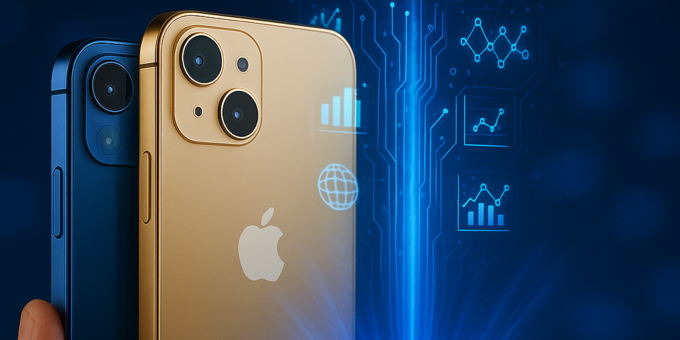
In the vast galaxy of smartphone innovation, Apple shines like a supernova. With every keynote, the tech giant pushes the boundaries of what we consider possible in mobile communication, design, and artificial intelligence. The iPhone isn’t just a phone—it’s a symbol of technological elegance, engineering mastery, and user-first innovation. From chips that rival desktop computers to sensors that save lives, Apple continues to lead the charge toward the future of smartphone technology.
Why Apple’s Vision Matters for the Smartphone Industry
What sets Apple apart isn’t just its size or market share—it’s the clarity of its vision. Apple doesn’t follow trends; it creates them. The company’s strategy revolves around a vertically integrated ecosystem, obsessively engineered hardware, and software that anticipates user needs. Whether it’s the introduction of Face ID or the removal of the headphone jack, Apple’s decisions often spark industry-wide shifts.
Minimalist Aesthetics and Functional Brilliance
Design isn’t decoration—it’s function refined. Apple’s dedication to minimalism goes beyond just looks. Every curve, material, and button serves a purpose. The iPhone’s industrial design philosophy, from the flat-edge redesign of the iPhone 12 to the aerospace-grade titanium in the iPhone 15 Pro, is meticulously crafted for durability and performance.
In an era where foldables scream for attention, Apple whispers with purpose—and yet speaks volumes.
Apple Silicon and the A-Series Chips Revolution
Perhaps the most groundbreaking leap has been Apple’s transition to in-house chipsets. The A-series Bionic chips are not just faster—they’re smarter. The neural engines within these chips perform trillions of operations per second, enabling real-time machine learning tasks like facial recognition, AR mapping, and intelligent photography.
With chips like the A17 Pro, Apple is ushering smartphones into a new dimension of performance—rivaling consoles and laptops with astonishing efficiency.
Seamless Integration of Hardware and Software
Apple’s tight control over both hardware and software allows for optimization that’s practically unmatched. iOS is designed specifically for iPhone hardware, meaning fewer bugs, smoother animations, and faster updates. From widgets to dynamic island interactions, the symbiosis between touch, sight, and sound in the Apple experience is unparalleled.
Face ID, On-Device AI, and Privacy First Approach
Security isn’t just a feature at Apple—it’s a philosophy. Face ID remains the most secure biometric system on any smartphone. Data like facial scans never leave the device, and features like App Tracking Transparency ensure users control who sees their data.
With end-to-end encryption and on-device AI, Apple is rewriting the playbook on mobile privacy.
Sustainability and Recyclable iPhone Designs
Apple has pledged to be carbon-neutral by 2030 across its entire supply chain. Recent iPhones are made with 100% recycled aluminum and rare earth elements. The packaging is plastic-free. And the company even built robots—like Daisy—to disassemble and recycle iPhones.
This isn’t just greenwashing—it’s the greening of tech at scale.
iOS, iCloud, and the Apple Ecosystem Effect
No smartphone is an island—unless it’s an iPhone in the Apple ecosystem. AirDrop, iCloud Drive, Handoff, Universal Clipboard—these aren’t buzzwords. They’re everyday magic for Apple users. Whether you’re starting an email on your MacBook or editing a Note on your iPad, everything just flows.
This lock-in, while criticized, is the glue that keeps millions loyal.
Vision Pro and Apple’s Leap into Spatial Computing
Apple’s Vision Pro is more than a headset—it’s a declaration. With spatial computing, Apple is blurring the lines between mobile, desktop, and immersive environments. The iPhone, as a controller for the future AR/VR experience, will evolve from a communication tool to a mixed-reality companion.
Imagine FaceTime in 3D or photo libraries that surround you. Apple’s future isn’t just smart—it’s spatial.
6G, Wi-Fi 7, and Beyond
Apple isn’t just preparing for the next-gen network; it’s shaping it. Rumors suggest Apple is working on custom 5G and 6G modems. While competitors race to adopt Wi-Fi 7, Apple refines the tech, ensuring it meets their exacting standards for speed, energy efficiency, and low latency.
This cautious ambition keeps Apple at the cutting edge without compromising user experience.
Siri’s Evolution and Edge AI Development
While Siri once lagged behind rivals like Google Assistant, Apple is catching up through on-device machine learning. By processing data locally, Siri becomes faster, more private, and contextually aware. The evolution of Siri isn’t loud—but it’s quietly becoming the most secure voice assistant in the business.
ProMotion and OLED Advancements
Apple’s display technology continues to set benchmarks. From Super Retina XDR to ProMotion 120Hz refresh rates, iPhone screens deliver vibrant visuals and buttery-smooth interactions. The move toward MicroLED and energy-efficient panels shows that Apple isn’t just chasing visual fidelity—it’s pursuing longevity and battery optimization.
Computational Photography and Deep Fusion
Gone are the days when more megapixels meant better photos. Apple redefined smartphone photography with Deep Fusion, Smart HDR, and Photonic Engine. With AI and custom image signal processors, the iPhone captures studio-quality images in real-world settings, whether in low light or rapid motion.
Health Sensors and Emergency Features
Apple’s smartphones are becoming healthcare companions. Fall detection, Emergency SOS via satellite, and the potential for non-invasive glucose monitoring are transforming iPhones into wellness tools. In emergencies, these features are more than helpful—they’re lifesaving.
Custom Power Management and Eco Charging
Battery life has always been a concern. Apple tackles this not just with hardware, but with software intelligence. Features like Optimized Battery Charging reduce wear and extend lifespan. And the use of custom power controllers helps iPhones last longer between charges—even with all-day performance.
Ceramic Shield and Durable Frame Materials
Apple partnered with Corning to develop Ceramic Shield—a material tougher than any smartphone glass. Combined with surgical-grade stainless steel or aerospace-grade titanium, these materials elevate both aesthetics and endurance.
It’s not just about looking premium—it’s about surviving daily life with grace.
iOS Accessibility and Customization Tools
Inclusion is built into iOS. Features like VoiceOver, Magnifier, and Live Speech help users of all abilities navigate the digital world. Apple’s commitment to accessibility isn’t performative—it’s practical, and continually evolving.
Taptic Engine and Sensory Interactions
Apple’s haptics are more than vibration—they’re communication. The Taptic Engine provides nuanced feedback that enhances gaming, navigation, and typing. It’s the invisible layer that makes the iPhone feel alive in your hand.
How Apple Redefines Market Expectations
When Apple removes a port or changes a form factor, critics howl—and then follow. Whether it’s ditching the home button or introducing the notch, Apple’s bold moves often set new industry norms. By controlling the narrative, they guide consumer expectations.
Apple’s Reach Across Cultures and Economies
From bustling cities in China to rural towns in America, iPhones are aspirational. Apple’s global supply chain supports millions of jobs, and its devices have become tools for education, business, and creative expression across continents.
Why iPhone Users Rarely Switch
Brand loyalty is sky-high. Why? Because Apple doesn’t just sell hardware—it creates habits. Once you sync your life into iMessage, iCloud, Apple Pay, and AirPods, switching ecosystems feels like a chore. And Apple ensures that loyalty is earned, not assumed.
Data Encryption and App Tracking Transparency
Apple turned privacy into a brand differentiator. From Mail Privacy Protection to iCloud+ Private Relay, Apple is giving users the tools to protect their data in a digital world where surveillance is the norm.
Apple’s Control Over Its Supply Chain
Unlike most tech firms, Apple owns or directly manages much of its supply chain. This allows for unprecedented control over product quality, ethical sourcing, and timely innovation. Their chip strategy and manufacturing partnerships ensure they’re never left behind.
Leading the Edge of Network Utilization
With 5G and soon 6G, Apple isn’t just chasing speed—it’s optimizing efficiency. Their integration with carriers and commitment to mmWave in select markets shows a strategic, data-driven approach to connectivity.
Screen Time and Focus Modes for Mental Health
Digital wellbeing is a rising concern. Apple’s Screen Time, Downtime, and Focus modes help users reclaim control over their digital lives. Rather than exploiting attention, Apple is learning how to respect it.
App Store Standards and SDK Tools
The App Store remains a walled garden—for better and worse. But for developers, Apple’s SDKs, APIs, and TestFlight tools provide a stable, profitable platform. Despite controversies, the App Store is still where the best mobile apps are born.
iOS in the Corporate World
From BYOD setups to custom enterprise apps, iPhones have carved a niche in corporate IT. With top-tier security and MDM capabilities, iOS is not just consumer-friendly—it’s business-ready.
iPads and iPhones in Classrooms
Apple’s impact on education is profound. Through its Education Store, classroom software, and coding programs like “Everyone Can Code,” Apple is equipping future generations with tools to think, build, and lead.
Apple Stores as Experience Hubs
Every Apple Store is part theater, part temple. With Today at Apple sessions and Genius Bars, they aren’t just retail outlets—they’re physical manifestations of the brand’s commitment to user empowerment.
Diversity, Accessibility, and Philanthropy
From inclusive emoji to Supplier Responsibility Progress Reports, Apple’s social commitments extend beyond marketing. Initiatives around racial equity, accessibility, and renewable energy show a company striving to be better.
Apple’s Long-Term Blueprint for Smartphone Supremacy
Apple’s roadmap doesn’t stop at devices—it stretches into services, wearables, spatial computing, and sustainability. The smartphone may evolve, but Apple will shape what that evolution looks like. It’s not about chasing what’s next—it’s about building it first.
FAQs
What makes Apple different from other smartphone makers?
Apple designs both its hardware and software, creating a seamless and optimized user experience. This tight integration allows for unique features and better performance.
How does Apple ensure privacy on its devices?
Apple uses on-device processing, encryption, and features like App Tracking Transparency to give users control over their data.
Is Apple really innovating, or just refining?
While some features are refinements, Apple leads in areas like chip development, privacy, and ecosystem integration. Its innovations often become industry standards.
Why do Apple products cost more?
Premium materials, custom chips, extensive R&D, and a robust ecosystem contribute to the cost. Apple also invests heavily in support and security.
Are iPhones good for businesses?
Yes, with enterprise-grade security, MDM support, and reliability, iPhones are widely used in corporate environments globally.
How is Apple preparing for the future of smartphones?
Through investments in AR/VR, AI, sustainable materials, and satellite connectivity, Apple is building the infrastructure for the next generation of mobile devices.
You Can Also Read : Latest Apple Smartphone Innovations: What Tech Lovers Need to Know
Apple is not just a technology company—it’s a cultural force, an ecosystem architect, and a relentless innovator. As the smartphone continues to evolve, Apple is leading the charge by blending artistry, intelligence, and responsibility. Its vision of the future isn’t just smart—it’s human-centered, privacy-respecting, and experience-driven.
